
丸万
Maruman
3.44
Shinbashi, Shiodome
「Japanese Sweets」
--
--
Opening hours: [Monday-Friday 9:00-20:00 [Saturday] 9:00-17:30
Rest time: Sundays and holidays Business hours and holidays are subject to change, so please check with the store before visiting.
東京都港区西新橋1-11-1
Photos
(20)
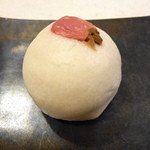

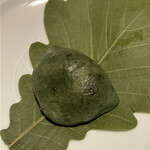

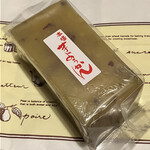







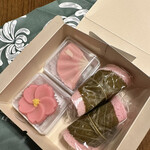






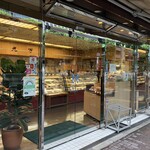
Details
Reservation Info
can be reserved
Payment Method
Credit cards accepted
(VISA, Master, JCB, AMEX, Diners)
Electronic money is not accepted
QR code payment accepted
(QR code payment is accepted (PayPay)
Private Dining Rooms
None
Smoking and Non-Smoking
No smoking at the table
Parking
None
Facilities
Calm space
Comments
(20)
kotapea
3.30
Located in Toranomon and Nishi-Shimbashi, this traditional Japanese confectionery shop has been around for a long time. You can enjoy the nostalgic atmosphere of the Showa era and traditional Japanese sweets. From Kusa Mochi, Kashiwa Mochi, and Kurimanju to more modern sweets like Dorayaki, they offer a wide range of options. On this day, I chose Kurimanju, which can be stored for a few days, for myself. Later, I enjoyed it with some tea. The chestnut filling makes it easy to eat as many as you want. Maybe next time I'll try the Kusa Mochi. Thank you for the delicious treat.



京湖
4.00
I came back for revenge, but for the second time in a row, my favorite burnt senbei was sold out. Today, I came all the way here again, but it's still not available! I ended up buying some fresh sweets and other senbei instead. They said the summer sweets will be ending soon, so I also bought some Mizumanju, etc.




マカデミア
3.70
I stopped by a bright and glass-walled traditional Japanese sweets shop on my way back from a one-day job in Hamamatsucho. They had a wide variety of Japanese and Western-style sweets! I bought some kashiwa mochi with yomogi (mugwort) filling, cream dorayaki, and sweet potato yokan. The kashiwa mochi came in three flavors - smooth red bean paste, yomogi filling, and miso paste, and I managed to get the last one with yomogi filling. The red bean paste was delicious! The cream dorayaki (requires refrigeration) had red bean paste and cream sandwiched between fluffy pancakes. The cream was delicious and went well with the pancakes. The sweet potato yokan had a simple ingredient list of beni azuma sweet potatoes, sugar, and agar. It had the natural flavor of sweet potatoes. I might visit again if I have the chance.

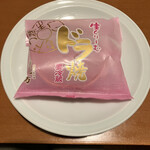


Pekoe
3.40
The lifespan of Kashiwa-mochi is short, while Sakura-mochi lasts longer, why is that? Anyway, I love Kashiwa-mochi. How many can I eat this year? Maruman's version is a bit too sweet with the red bean paste, but the main part is elegant and nice. For some reason, the kneaded sweet bean paste also tasted very sweet that day. Was it like this before? I heard that Kashiwa-mochi changes depending on the weather that day, such as humidity and temperature, so it's tricky. I'll visit again soon.




Pekoe
3.70
I used to not like sakura mochi, but I ended up reordering it because it was so good. I wonder what kind of sakura mochi I had tried before. Thank you for making me realize how delicious sakura mochi can be! I also tried some of my favorite nerikiri, and it was on a whole other level. My daughter, who usually thinks nerikiri tastes the same everywhere, even agreed that this one was different and delicious. I had a lot of other delicious treats that day, and it made me very happy. I can't wait for the short-lived seasonal treat of kashiwamochi, my favorite wagashi.




Pekoe
3.70
I was drawn in by the charming atmosphere of a lovely traditional Japanese confectionery store and decided to go inside. As soon as I entered, I felt a sense of elegance. Unfortunately, they had sold out of fresh sweets and wouldn't be able to make more in time, but the gentleman at the store recommended their cherry blossom mochi. Although I wasn't a big fan of cherry blossom mochi, I decided to give it a try. They packed it in a paper bag, which emitted a delightful scent even when placed in my tote bag. This was a first for me. The aroma was so lovely. And, as expected, the recommended cherry blossom mochi was truly delicious. I had never come across such a tasty cherry blossom mochi before, which made me realize that perhaps I didn't like it because I hadn't found a good one until now. It was chewy yet not overly sweet, with just the right amount of cherry blossom leaf. I actually ended up eating half of it before taking a photo, so this angle is not the best...haha. The nerikiri was also incredibly delicious. Even my daughter, who usually can't tell much difference between nerikiri from different places, said, "This one is totally different." Truly a renowned old establishment in Shinbashi and Uchisaiwaicho. I will definitely be going back.


あてるい
3.60
On this day, after having lunch at Toriyoshi, a yakitori restaurant near Toranomon intersection, I decided to relax at Kusamakura, a cafe nearby. I had originally planned to visit Okano Eizen, a shop I hadn't been to in over 10 years, but it was in the opposite direction from the Lawyer's Association building where I had to go next. I didn't want to risk getting caught in the predicted afternoon thunderstorm, so I gave up on the idea. Instead, I went a little further towards Shinbashi from Kusamakura and found a traditional Japanese sweets shop. The shop was located on the first floor of an office building, with a long glass display case filled with various Japanese sweets in boxes and assortments. There were also rice crackers displayed on a platform in front of the display case. The shop, established in 1947, didn't have the atmosphere of a historical store from the Edo or Meiji period, but the selection of sweets was quite traditional and classic. It felt like a typical post-war Showa era shop. Inside the display case were two middle-aged men, one in a white shirt and the other dressed like a confectioner. It was unusual to see only men working at a Japanese sweets shop. I chose three seasonal sweets within my budget: Mizu Daifuku for 200 yen, Yuzu Manju for 140 yen, and Tsuyukusa for 260 yen (all prices including tax). However, when I went to pay, I was charged 70 yen more than I had calculated because the confectioner misheard my order and priced the Mizu Daifuku instead of the Yuzu Manju. After pointing out the mistake, the correct amount was finally calculated. The staff were very polite and humble, despite my amateurish mistake. The shop was listed on Tabelog as "Favored by Various Government Agencies," so I had expected a more prestigious atmosphere, but it was quite the opposite. The receipt showed the shop's name as "Gokashiji Maruman," and the government agency claim seemed to be just a marketing slogan. I wondered why the shop was still listed under that name on Tabelog. Although I didn't buy it this time, there were discounted imperfect chestnut manju (150 yen instead of 200 yen) on a basket above the display case, which seemed like a good deal for take-home treats. After finishing my business at the Lawyer's Association building and heading back, I was caught in a sudden thunderstorm near Sakuradamon Station. I had forgotten to bring an umbrella, so I had to seek shelter at a building near Ichigaya Station until the rain subsided. Finally, I made it back to my workplace and enjoyed the Japanese sweets I had bought with some green tea. All the sweets were traditional and well-made, with a subtle sweetness and a pleasant texture. The prices were also reasonable, which was a plus.




あさんて
3.50
Blog "Tokyu Line, Foodie Adventures" - https://asante.blog/
Lately, I've been really into traditional Japanese sweets more than Western desserts. I tried their famous chestnut bun this time, after having their fresh confectionery before. I only bought two to take home, but I love that you can buy just a few pieces. So, time for some tea. The chestnut had a soft texture and a delicious chestnut flavor, as expected from a famous treat. It was wrapped in a slightly thick skin made from azuki beans they prepare in the shop. The larger size was very satisfying, and the browned color was appealing. It was a chestnut bun that was solid and reliable, not flashy. It had a comforting taste that seemed fitting for being "officially approved by various government agencies." Thank you for the meal.

*お出かけ日和*
3.30
Located in Nishi-Shimbashi, Minato-ku, Maruman is a traditional Japanese confectionery shop favored by various government offices. They have been making their own anko (sweet red bean paste) since their establishment in 1947.
Items purchased:
- Kashiwamochi with miso anko and whole chestnut (170 yen each)
- Chestnut manju (200 yen each)
- Dorayaki (200 yen each)
Review:
- Kashiwamochi with miso anko: A unique yellow appearance with plenty of miso anko inside. As someone who hasn't had many miso anko sweets before, it was a fresh experience. Highly recommended!
- Chestnut manju: A traditional taste with a whole chestnut wrapped in a thin skin.
- Dorayaki: A dorayaki with a chrysanthemum pattern on top. Moist cake with plenty of anko and chestnut filling.




あさんて
3.40
Blog "Tokyu Line, Food Walk" - https://asante.blog/
Received these traditional Japanese sweets as a souvenir from my family. The shop is known as "Official Supplier to Various Government Agencies," which caught my attention. The four types of fresh sweets I brought back were wrapped with great care, truly living up to their reputation. The colorful sweets were not overly flashy in appearance, exuding a subtle elegance. Before tasting them, I took a moment to admire their beauty. Each sweet had its own unique characteristics, but this time, I particularly enjoyed the green one. It had a twisted, rope-like appearance, and the balance between its texture and the sweet bean paste inside was delightful. All of them were safe and delicious to eat. Thank you for the meal.




miao0713
4.00
During my lunch break at work, I decided to take a stroll and stumbled upon a lovely Japanese confectionery shop in the Toranomon area. Without any prior research, I was impressed by the kindness of the staff and how it made time seem to slow down a bit. It's no wonder this area is known for its charm. I couldn't resist getting some sakuramochi, a treat I always crave this time of year. And I also found the burnt chestnut bun quite interesting. After work, I treated myself to a tea time with these sweets! The sakuramochi was elegant and generous, with a chewy skin, a hint of saltiness from the cherry blossom leaf, and a lovely aroma. It truly felt like a work of art that can be savored in this season. As for the chestnut bun, the shiny crust, the subtle sweetness of the red bean paste inside, and the rich flavor of the chestnut made it all so comforting. Knowing that such delicious treats are just around the corner gives me the motivation to keep going at work. Thank you for the wonderful experience!
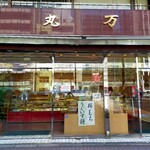
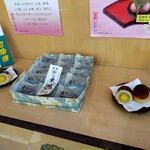


シーリア
3.00
In Shinbashi, I went to a shop on Sotobori Street in search of sakuramochi. After lunch, there were about five other customers, and I hesitated, wondering if it was because of Hina Matsuri. I confirmed the price of sakuramochi at 190 yen and was grateful to the attentive staff who noticed me among the four or so employees. I ordered enough for everyone, had the sakuramochi put in a free paper bag with a sticker, paid with a cashless payment, took it home, and compared it to sakuramochi from another shop for dessert at dinner. Sakuramochi is made of sugar, red bean paste, and rice flour, with the rice flour dough wrapping the red bean paste. I learned that the sakuramochi I had at a mountain lodge in Kyoto on a school trip when I was 15 was a Kansai-style daifuku. Despite going against tradition, I ended up eating the sakura leaf, but the ones left by my family still filled the kitchen with fragrance the next morning.



letsgoswallows
4.10
I visited a shop located about a 10-minute walk from Shinbashi Station. It faces a main street, and the wide entrance of the store makes it relatively easy to find. In the store, they sell both traditional Japanese sweets and Western-style sweets, with various types of sweets displayed in a large showcase. This time, I purchased only traditional Japanese sweets, including sweet potato yokan, bean daifuku, kaki no tane, and warabi mochi. The sweet potato yokan left the strongest impression on me. It had a moist texture, a strong sweet potato aroma, and a sweetness that is hard to describe but very memorable. The bean daifuku and kaki no tane were both sweet with a traditional sweetness, yet not overpowering, giving a sense of modesty. The warabi mochi was packed in small portions, rare to see, with a moist and distinctly sweet taste. Overall, the traditional Japanese sweets had a refined sweetness, not overpowering, and exuded an elegant taste.




Morirou21
3.50
Maruman in Nishi-Shimbashi, Minato-ku, Tokyo. A traditional Japanese confectionery shop that offers a wide variety of sweets for customers at various government offices in Kasumigaseki. Established in 1947. The nearest stations are Uchisaiwaicho Station on the Toei Mita Line and Toranomon Station on the Tokyo Metro Ginza Line. Located along Sotobori Street. I purchased their famous dorayaki with a design of twelve chrysanthemum crests for souvenirs. The shop has a long, spacious interior. They offer a wide variety of Japanese sweets. The staff, two of them, provided attentive service. Today's order: Chestnut dorayaki x3 for 200 yen each. The dorayaki is filled with plenty of homemade chestnut paste and is quite substantial for the price. It looks great and can last for about a week, making it suitable for gift-giving along with other sweets. #Runner-up #Japanese sweets #Long-established #Official supplier to government offices #Sweets #Souvenirs #Japanese sweets #Gifts #Sotobori Street #Dorayaki #Takeout #Likely to revisit.




miiyuuuu
3.50
In Minato City, Tokyo, Wagashi Maruman☆Daifuku☆Grilled Mochi☆Warabi Mochi has delicious sweet red bean paste. The warabi mochi's kinako powder is finely ground and light, making it dance lightly when eaten, but once in the mouth, it becomes smooth and gooey. There are many other traditional Japanese sweets available, so you'll have to visit multiple times to try them all.


しめこのうさぎ
3.00
A traditional Japanese confectionery shop located on the 1st floor of a building right next to Uchisaiwaicho Station on the Tokyo Metro Mita Line. They offer a range of Japanese sweets, from everyday treats to high-end confections. The prices are reasonable, and the portion sizes are generous. The sweets are quite sweet, but the flavors of the ingredients are not very pronounced, giving them a traditional taste. While it may be better than your average local confectionery shop, it may not be considered top-tier for high-end confections. Given its proximity to the Imperial Household Agency, it is possible that this shop caters to various government offices as well.

ぽんぽこ猫
3.50
You can walk to the restaurant from Shinbashi Station in about 5 minutes. It's located along a main street, so it's easy to find. They sell individual items like chestnut steamed buns (1 piece for 190 yen), dorayaki (1 piece for 180 yen), and baked Mont Blanc (matcha flavor) (1 piece for 240 yen). The chestnut steamed bun has a rating of 3.5. It's a small size, not too sweet, and has a great balance of white bean paste and chestnut. This would make a great souvenir. The dorayaki has a rating of 3.0. The red bean paste is elegantly sweet, but the pancake part is dry. It looks like a representative sweet of the shop with words like "Official Supplier to Various Government Agencies" and "Ten Thousand" written on it, but it was not that great. The baked Mont Blanc (matcha flavor) has a rating of 3.0. It has a matcha milk flavor with almost no bitterness from the matcha. The moist Mont Blanc dough is delicious, but personally, I didn't think the matcha flavor was necessary. I regret not sticking with the regular flavor. It might be good for those who like matcha milk flavor. If you visit Maruman, I recommend getting the chestnut steamed bun.




Cozy35
3.30
- Dorayaki: ¥180 including tax
- Chestnut bun: ¥190 including tax
This is a long-established Japanese confectionery shop located about a 5-minute walk from Toranomon Station on the Tokyo Metro Ginza Line. The shop was established in 1947, making it quite a longstanding establishment, but since it's located on the first floor of a building, you wouldn't necessarily feel the traditional atmosphere from the outside. It's known to be a supplier to various government offices, which adds to its reputation, but the prices are actually quite reasonable for a shop in the city center. They offer a wide variety of sweets, making it difficult to decide what to buy. Personally, I bought the dorayaki that I wanted to try and one of their specialties, the chestnut bun. When I got home, I enjoyed them with some green tea.
(Review)
The dorayaki had chestnuts inside, but other than that, it was quite ordinary. There wasn't anything particularly noteworthy about the texture of the red bean paste, sweetness level, or the castella sponge cake. The chestnut bun was also similar to the ones often sold at hot spring resorts. It was a normal and tasty snack. Considering the reasonable prices, I think that's a good point. Despite being a supplier to government offices and a long-established Japanese confectionery shop in the city center, it's actually a familiar and approachable place. Thank you for the meal.



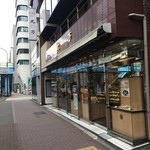
slr7
3.50
On December 21, at 18:30 in Tokyo's Uchisaiwaicho, as the last year-end of the Heisei era approaches, the streets are bustling with Christmas Eve x4 celebrations. Against the crowd of people heading from Shinbashi towards Uchisaiwaicho, I walk to buy some New Year's sweets. Soon, I arrive at a traditional Japanese confectionery store. The staff members are dressed in white coats, fitting the image of a Japanese confectionery store. Established in 1947, this long-standing store exudes a sense of dignity as a supplier to various government offices. This time, I came for the "Baked Mont Blanc" cake, which I discovered through a gift I received. As I look around the store, I see not only the "Baked Mont Blanc" but also other authentic Japanese sweets displayed in glass cases. (I forgot to take a photo!) Since I was there, I decided to choose something similar to the "Baked Mont Blanc". Baked Mont Blanc - 240 yen: A Mont Blanc cake made without wheat flour, wrapped in a chestnut paste dough, and baked after being coated in honey. The chestnut-rich dough is not too sweet or heavy, and the encounter with the chestnut in the center will surely be well-received by everyone. With a shelf life of one month, it is also perfect for gifting. Matcha Baked Mont Blanc - 240 yen: Honey-soaked chestnuts with skins, wrapped in a chestnut paste dough and baked, topped with matcha bean paste and red beans. The combination of matcha and chestnut is delightful. Raw Caramel Sweets - 240 yen: A baked confectionery with Belgian white chocolate raw caramel kneaded into the dough, creating a moist caramel chocolate cake with raw caramel in the center. Iwaguri - 160 yen: A large chestnut candied in syrup, wrapped in chestnut paste, and further encased in a steamed bun. As the name suggests, this Japanese confectionery allows you to enjoy both chestnut and chestnut. Despite the reasonable pricing, the other beautifully crafted Japanese sweets, which seem to have been made by skilled artisans, also looked delicious. Thank you for the meal.




Nov1
5.00
I bought Ginza cakes. I was able to use PayPay. It was delicious.

Email Login